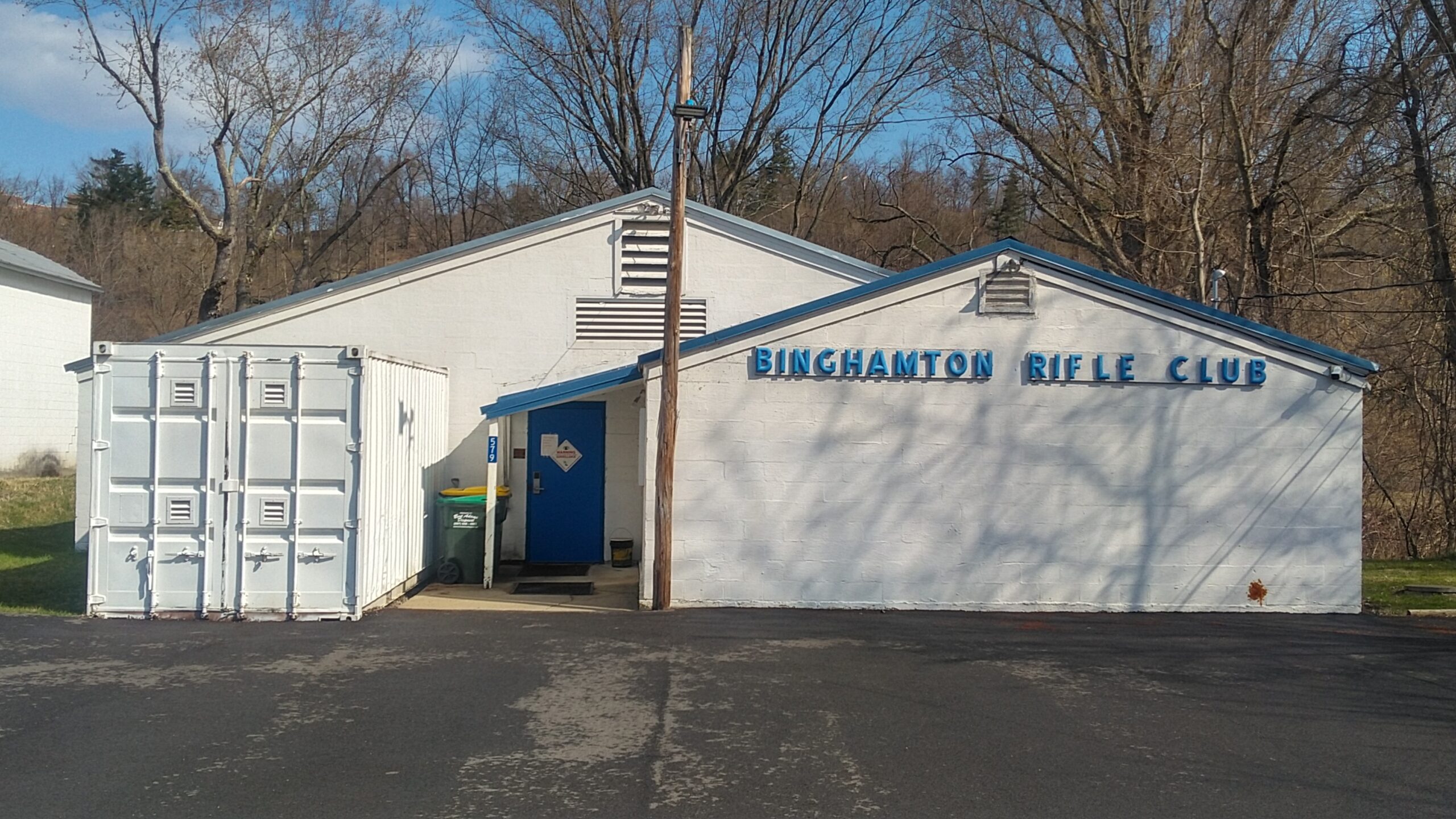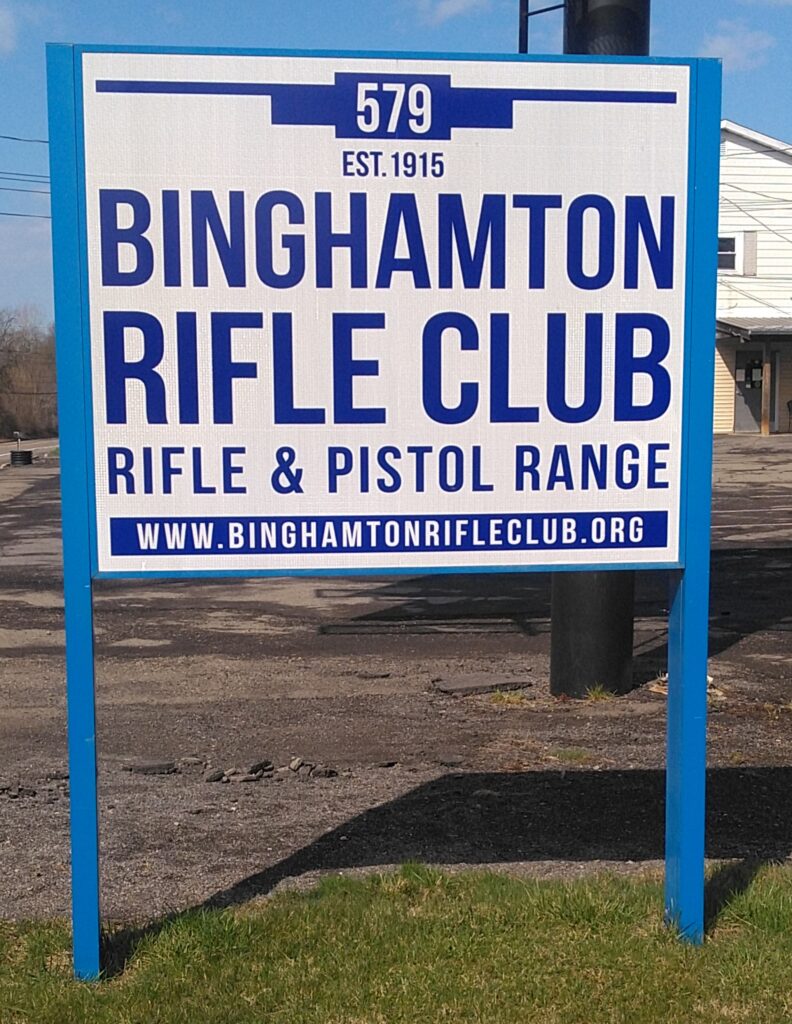History

The earliest written records of the Binghamton Rifle Club are minutes of a special meeting held June 22, 1915, in the Kilmer Building Office of President Ray C. McHenry. The club possessed no range but secured agreement to fire high power rifle practice and qualification scores on a National Guard range near East Union for a daily rental of one dollar. By November 1915, permission was granted to practice indoors at the State armory on Washington Street.
Minutes of the January 10, 1916, “annual” meeting state that the club formally organized in June 1915 with 50 charter members with 43 more joining during the year. Members had ordered 35 Krag and 14 Springfield Rifles, 20 thousand rounds of 22 ammunition, 5 thousand Krag and 3.6 thousand Springfield ammunition. Dues for the club were $2.00 per year with a $2.00 initiation fee. Payment of $5.00 for 1916 NRA dues was approved. Club members occupations were as varied as at present, comprising: lawyers, plumbers, students, jewelers, contractors, a street car conductor, painter, machinists, an elevator operator, an insurance broker, the Comptroller of Security Mutual Insurance, a butcher, surgeon and even a Supreme Court Justice (the Honorable George F. Lyon).
On June 24, 1916, the club filed a Certificate of Incorporation as the Binghamton Rifle Club, Inc. with Justice Lyon officially approving the incorporation papers. These papers were entered in the Office of the Secretary of State on June 28, 1916. The club by-laws were submitted to the NRA for approval at that time although our earliest copy of an NRA Charter is dated February 1919.
In the fall of 1916 the club obtained from Hiram M. Rogers, a long term lease for land above Port Dickinson as an outdoor range. Labor and many materials for range construction (Target butts/Carriers) were donated by members but out-of-pocket costs approached $300.00. Members contributed $10.00 dues advancement to cover this. Due to the late season construction only 39 members fired in 1916 with 20 qualifying as marksmen or better. The National Guard, particularly the 4th Regiment was granted permission to use the range. Military practice and civilian training persisted during the war years. The club meeting minutes after 1916, show 80 members in good standing on January 13, 1917, but that had dwindled to 22 by June 1922, reportedly due to loss of the indoor range for an undisclosed reason. Records and memories provide sparse data from 1923 to the mid 1930’s, but the Port Dickinson range survived and was in active use by several organizations into the 1940’s. Remnants of the range exist today where a few hunters try to sight in prior to deer hunting season.
No pistol shooting was mentioned in these early records but it was pistol shooting that brought the club back to action in the late 1930’s.
Formation of the Interstate Revolver League (now the Interstate Pistol Association) brought out teams from the Binghamton Police, Broome Sheriff’s Department, IBM, Oneonta Police, Susquehanna R&R Police, Towanda, and finally a group known as the Parlor City Pistol Team. The sparkplug of the Parlor City Team was Bernie Dwyer, a nationally known small bore rifle shooter from Syracuse who was transferred to Binghamton in 1937 and gradually shifted his shooting interest from small bore and gallery rifle to pistol. The Parlor City Pistol Club gradually resumed the name of the Binghamton Rifle Club as members fired 22 caliber gallery rifle scores in the Empire-Keystone Rifle League against teams from Ithaca, Candor, IBM, Agfa Ansco and Cortland. There even exists an NRA Charter for a “Ranger Rifle Club of Binghamton” issued 6/17/41 which is thought to be a sideshoot of the Binghamton Rifle club.
Originally the Parlor City Team and the League fired the Army L Target & Course, mostly with center fire revolvers. Because of the large target size scores of 295 to 300 were common, but by 1940, the more difficult Camp Perry targets predominated (slow, timed and rapid fire on the same rapid fire target) and scores were lowered from the Army L Course. When the league was reorganized in 1947, the NRA Gallery Course and Targets were adopted and scores became comparable to these fired today.
The Parlor City Pistol Team fired on a makeshift range in the old railroad round house off Broad Avenue until the building vas demolished during World War 2. The Binghamton Rifle Club rented a range at 201 Water Street in the early 1940’s. Here, in 1943 the club ran marksmanship training courses for men who expected to enter the armed forces. Due to lack of ammunition and loading components there was little civilian shooting during the war.
By 1946 the Binghamton Rifle Club constructed a range on the 4th floor of the Darling Meat Packing building on Depot Street. Gun boxes were lighter in those days, but it was a long walk up especially when using your spare hand to carry up a chunk of cord wood to feed the stove. Still this range was used for nearly five years of league competition.
The modernization of the present Binghamton Rifle Club, Inc., stems from the decisive step taken July 14, 1950, when we purchased a deed to the Rustay property on Conklin Avenue and drew up building plans for our own range. Substantial construction did not emerge until 1953 after a dozen members advanced up to 4 years dues (then $25) to buy those building materials that could not be scrounged. All labor was of course donated. First shots were fired in 1954 in the buildings single room with a cinder floor, stationary targets and a huge household coal furnace for heating. The first merchandise match was held April 1955.
During that summer a concrete floor was poured in the ready room, a partition erected to separate the firing line and a $641 gas furnace installed. Turning targets came in 1956. In the Spring of 1959 our famous “bowl” match was held to finance our indoor plumbing in the form of a blister building housing the stat office and restrooms. The “Brassard” for this “bowl” match became a much sought after item amongst shooters.
As the facilities improved, membership increased and for more that 30 years now the club has maintained at least 3 teams firing in the Interstate Pistol Association League, as wel1 as many informal members who just like to test fire their guns or practice on their own. In the Spring of 1960, the Binghamton Club began holding one Section of the New York State Indoor Pistol Championship – a practice that has continued most years. This required much work by many people, but monies earned from the matches are plowed back to pay for capital improvements to the facilities. The annual dues and maintenance fees pay only the operating costs of the range.
Today our range represents one of the best privately owned ranges in New York State in terms of both size and shooter comfort. With its 15 firing points at 50′, large ready room with spectator windows, restrooms, kitchen & scoring room, the club supports many types of shooting beside the basic gallery course competition with 22, Center fire & 45 caliber shooting. In addition we have several other shooting programs including:
- SporteRifle
- International Free Pistol, Standard Pistol, Centerfire Pistol, and Rapid Fire Pistol.
- Gallery and International Style 22 Rifle.
- International air rifle & air pistol (note local, state sectional tournaments are regularly held in all of above).
- Explorer Scouts Rifle Competition.
- Frequent Pistol Marksmanship Courses.
Any attempt to cite those individuals who have contributed most substantially to the organizations and growth of the Binghamton Rifle Club would risk slighting or offending perhaps equally deserving persons. By confining this list to those persons who are no longer with us, we can recognize their efforts yet not offend the many people who remain the stalwarts of the club today. Later chroniclers can cite the contributions of the many deserving workers still on the scene.
Foremost recognition must go to Roy C. McHenry, Douglas Ashley & Raymond H. Moody who alternated as Club President, Treasurer and Secretary in the formative years of 1915 to 1922. Then must come Bernard G. Dwyer, Albert Hess, Dr. Carlon Goodman, Brezzi Obrien, Ralph Adriance, and Clifford Long who brought the club from the Parlor City days through several makeshift quarters to the planning, construction and improvements to our present building. We must also make special mention of Ralph A. Copeland (whose droll cartooning ability is still evident in the many instructional signs around the range) for his operational innovations, intriguing communications and sheer hard work for both the club and the Interstate Pistol Association.

